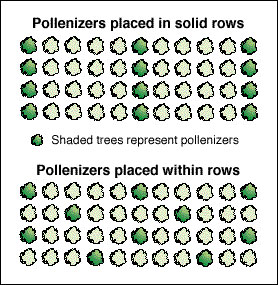Apple pollination
Michele R. Warmund
Department of Horticulture
University of Missouri
All varieties of apple trees should be cross-pollinated with another
apple or crabapple variety. To attain the best fruit set on apple trees,
the king blossom (the largest and first one to open) in the flower
cluster must be pollinated. Thus, the bloom periods of the pollinizer
and the king blossom of the apple tree must overlap.
In backyard plantings, two semidwarf apple varieties that bloom at
the same time should be planted within 50 feet of each other. Two dwarf
apple varieties with similar bloom periods should be spaced less than 20
feet apart to ensure the transfer of pollen between trees (Figure 2).

Figure 2
Apple and crabapple bloom periods. The shaded area represents the time
of bloom.
Although some apple varieties, such as Lodi, Liberty, Empire, Winesap,
Jonathan, Jonagold, Gala, Golden Delicious, Rome and Granny Smith may be
listed as self-fruitful, they will set more fruit on an annual basis if
they are cross-pollinated. Additionally, some apple varieties, such as
Winesap, Stayman, Mutsu and Jonagold, produce sterile pollen and
therefore cannot be used to pollinate other apple varieties. Many
nursery catalogues include pollinization compatibility charts (Figure 3)
or recommend good apple varieties to use as pollinizers.

Figure 3
Apple pollination. Except where indicated, varieties listed on
the left can be used as reliable pollinizers for cross-pollination.
Manchurian crabapple, with profuse white flowers, is commonly used to
pollinate early- to mid-blooming apple varieties, while Snowdrift
crabapple is used for mid- to late-blooming apple varieties (Figure 2).
When using a crabapple tree as a pollinizer, it should be planted within
a similar distance to an apple tree as listed above.
In situations where a solitary apple tree is planted, branches of
open fresh blossoms of another apple or crabapple pollinating variety
can be placed in buckets of water and hung in the tree. Another way to
ensure pollination where a single tree is planted, is to top-work or
graft another apple variety onto the existing tree. To top-work an apple
tree, 6- to 8-inch sections of branches of one apple variety are
cleft-grafted onto terminal branches of another variety.
In commercial apple plantings, a row of pollinizer trees is often
planted between every four rows of the main variety of trees (Figure 4).
If pollinizers are placed within the row, every fifth semidwarf tree is
a pollinizer and each pollinizer is offset in adjacent rows to stagger
them throughout the orchard block. In high-density plantings of dwarf
trees (5 to 6 feet between trees within the row), apple or crabapple
pollinizers may be planted between eight to ten trees of another variety
in the row.

Figure 4
Alternative planting plans to ensure cross-pollination of apple trees.
Beehives are generally placed in commercial apple orchards as the
king flowers open. If hives are brought in before this time, bees may
forage flowers of other broad-leaved plants instead of the apple
blossoms. For this reason, dandelion flowers should be removed by mowing
or by herbicide treatment before hives are placed in the orchard. In
orchards where semidwarf trees are planted, one hive of a
medium-strength colony (15,000 to 20,000 bees) is generally sufficient
per acre. Two hives per acre are used in high- density orchards where
dwarf apple trees are planted. Extra strong colonies of as many as
50,000 bees have been effective in pollinating four acres of semidwarf
trees under ideal climatic conditions.
Michele R. Warmund
Department of Horticulture
Article link |